I am having such a great summer. I am 5 days later then I should be in writing my blog. But, I have a great excuse-For once it wasn’t my problem or procrastination. My husband Spencer had a rather sudden burning desire to go
 see his brother Mike in Great Falls. So we did! Didn’t
see his brother Mike in Great Falls. So we did! Didn’t  bother me in the least. I love talking to Maggie(sister-in-law)Lolo pass and 4th of July pass, the
bother me in the least. I love talking to Maggie(sister-in-law)Lolo pass and 4th of July pass, the  emptiness and wildness. So we went for a long weekend.
emptiness and wildness. So we went for a long weekend.I Love Great Falls
in the summer, because it reminds me of my childhood summers in College Place. But, not so much in the winter. I am fascinated by the turn of the century brick buildings, wide streets and old houses, Art Deco Fair buildings and weird finned swimming buffaloes AND, of course, we went to the State Fair. I was able to keep to my goal of learning how to use the camera effectively on my i-phone. Still keep cutting off heads with it. So, I have some great pictures to work into
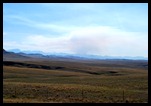 tapestries-if I
tapestries-if I  ever finish the
ever finish the piece I am working on.
piece I am working on. Being on the edge of nowhere
and looking out towards the dry grass and wheat lands. The sky really is
 bigger and brighter there. Oops, also saw a forest fire near Rogers Pass. Summer has it’s own particular smells. I hate it in the winter- cold AND SNOW--come to think about it I didn’t much like College Place in the winter-either. It’s a trip we used to make in a day-each way-now we make it in 2 days. We brought home Walla Walla Sweets for onion soup and Gramma’s Lakota pot au feu that goes on for days, blackberries for cobbler and fry bread with honey. And Antique metal work frills for the remodel that I hope to be done with by the last of September
bigger and brighter there. Oops, also saw a forest fire near Rogers Pass. Summer has it’s own particular smells. I hate it in the winter- cold AND SNOW--come to think about it I didn’t much like College Place in the winter-either. It’s a trip we used to make in a day-each way-now we make it in 2 days. We brought home Walla Walla Sweets for onion soup and Gramma’s Lakota pot au feu that goes on for days, blackberries for cobbler and fry bread with honey. And Antique metal work frills for the remodel that I hope to be done with by the last of September Unfortunately, reality eventually has to bite. Reality meant that I lost 5 days of weaving and will loose another 4 days to what was to be my reward for finishing “..and HE...” 4 days of intermediate level silversmithing classes with Don Norris, but I am not such a glutton for
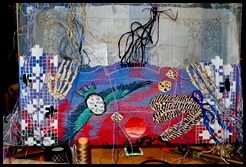 punishment that I’ll deny myself the pleasure of the classes just because I missed a deadline. I’ll just work a few more hours everyday weaving-“right,” she said sarcastically to whom ever would listen.
punishment that I’ll deny myself the pleasure of the classes just because I missed a deadline. I’ll just work a few more hours everyday weaving-“right,” she said sarcastically to whom ever would listen. So I’ll need to add another 5 days to my schedule. I think after I finish the lettering I’ll be about 90% of the way
 finished. Which means I am still not finished with “…And HE…” This is the piece that I was going to do 5 feet wide 6.5 feet tall on my large Shannock. The design seems to have gone on forever. It set on the loom for 3-4 years until I had an epiphany about needing to weave it in sewing thread and no wool. It lead to me selling my large Shannock. It just needs to be done!! I keep asking myself if I could have broken the design into smaller pieces or a series of small format pieces. Second guessing doesn’t seem to help it go any quicker. I don’t think it could have been. It’s definitely not a decorative piece. It tells a story. It has a narrative. Something I need to say to myself. There was a time that I though I could have broken the piece in half and still had a beautiful floral piece, but it would have lost all/ most of it’s impact, power and meaning. This quote keeps running through my head and journal and today it showed up on face book.-“Until you make the unconscious conscious it will direct your life and you will call it fate.”Carl Jung It keeps be stubbornly not wanting to give up on it.
finished. Which means I am still not finished with “…And HE…” This is the piece that I was going to do 5 feet wide 6.5 feet tall on my large Shannock. The design seems to have gone on forever. It set on the loom for 3-4 years until I had an epiphany about needing to weave it in sewing thread and no wool. It lead to me selling my large Shannock. It just needs to be done!! I keep asking myself if I could have broken the design into smaller pieces or a series of small format pieces. Second guessing doesn’t seem to help it go any quicker. I don’t think it could have been. It’s definitely not a decorative piece. It tells a story. It has a narrative. Something I need to say to myself. There was a time that I though I could have broken the piece in half and still had a beautiful floral piece, but it would have lost all/ most of it’s impact, power and meaning. This quote keeps running through my head and journal and today it showed up on face book.-“Until you make the unconscious conscious it will direct your life and you will call it fate.”Carl Jung It keeps be stubbornly not wanting to give up on it. So what’s new in the piece. I have started the scroll and am using linen thread to give it a different texture then the sewing and embroidery threads. I have started the gold soumack arabesque on the right side of the scroll. Gold threads can be a tad difficult to deal with especially those done in the style of aurum filatum. The weft bundles wear very easily,
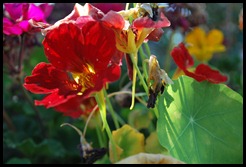 because it is generally a paper or gold foil wrapped around a core of line cotton or polyester. It seems to be best not to us a bobbin tip or beat down to hard on the weft soumack twiner because it takes very little to wear through and unspin the gold. I am using 6-8 inch lengths of weft. I am also knotting the weft every 3-4 inches with an overhand knot to help keep it under control when doing the soumack twists. The letters are much easier. They are vertical soumack done in the smaller perle cotton-The up rights are one warp wide.
because it is generally a paper or gold foil wrapped around a core of line cotton or polyester. It seems to be best not to us a bobbin tip or beat down to hard on the weft soumack twiner because it takes very little to wear through and unspin the gold. I am using 6-8 inch lengths of weft. I am also knotting the weft every 3-4 inches with an overhand knot to help keep it under control when doing the soumack twists. The letters are much easier. They are vertical soumack done in the smaller perle cotton-The up rights are one warp wide. | The arabesque is a form of artistic decoration consisting of "surface decorations based on rhythmic linear patterns of scrolling and interlacing foliage, tendrils" or plain lines,[1] often combined with other elements.- def. liberated from Wikipedia |
There are two different types of ridging in tapestry-one good and one not so good...
1. The ridge structure is actually a rib structure that is created by changing the shed
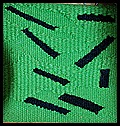 and weaving multiple passes one on top of another. The valleys between the higher part of the rib is caused when the weft passes to the back of the warp. The rib or hill is created when the weft passes in front. The rib and valley structure run up the length of the warps. Rib structure and size is controlled by the size of warp, the size of the weft and the distance between two warps.Please note in this example the rib structure is woven at both 10epi and 5 epi by doubling up the warps to change the rib structure.
and weaving multiple passes one on top of another. The valleys between the higher part of the rib is caused when the weft passes to the back of the warp. The rib or hill is created when the weft passes in front. The rib and valley structure run up the length of the warps. Rib structure and size is controlled by the size of warp, the size of the weft and the distance between two warps.Please note in this example the rib structure is woven at both 10epi and 5 epi by doubling up the warps to change the rib structure. Generally tapestry is considered to be an unbalanced weave structure more weft shows then warp. In a perfect world the warp size equals the distance between two warps and warps equals the size of the weft bundles-sort of. There are reasons you might wish to unbalance one of the elements. To give an example-If you are weaving at 10 epi you can generally use a 12/6 or a 12/9 cotton seine twine with a bundle of 4 needlepoint yarns or paternayan.,5-6 Norwegian Elv yarns or Australian 20/2 wool. 12/6 will generally accept more passes in an inch allowing for more turns or hatches or hachures then 12/9. Because a 12/6 is smaller and there is slightly more weft in an inch of weaving the tapestry is more drapable. The 12/9 because it is larger and thicker will take fewer passes and be stiffer. The hand of the fabric is less drapable. You could work 2 warps together as one to change the weft and warp structure for texture or to allow a larger weft bundle with many more elements in the weft bundle. The hand of the fabric will be softer the when it is woven at 10 epi. Another reason to unbalance the weft bundle is suppose you are working in a very detailed
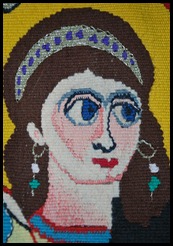 area you may need more passes in a given a space for detail or may need to have more hatches or hachures in a given area. Note eyelashes, chin and collar for very small hatches that were less then half the weft bundle in order to double up the amount of hatches in a given area. By making the weft bundle smaller you can get more passes of the weft bundle in a given area.
area you may need more passes in a given a space for detail or may need to have more hatches or hachures in a given area. Note eyelashes, chin and collar for very small hatches that were less then half the weft bundle in order to double up the amount of hatches in a given area. By making the weft bundle smaller you can get more passes of the weft bundle in a given area. The rib structure can be and often is flattened by pressing with a damp cloth. I prefer to not mess with the rib structure because in doing so you mess with the natural properties if inter-inflection and reflection of the light and colour that is inherent in the wools and fibers used to create tapestry that give a sort of inner glow as the light is captured in the hairy properties of the weft and the rib structure of the tapestry.So this type of ridging or rib structure is a good thing.
The second type of ridging or organ pipes is caused by adding to much weft in a pass or half pass
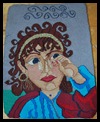
 Notice the organ pipes in the grey background.on the right. I now know that all I would have had to do to get rid of the pipes would have been to use less weft in the bubble and tighten my warp so the piece would have woven without the wefts shifting. Often times tapestry weavers will have a tendency to add more weft or a larger weft bubble going in a specific direction creating pipes. If you know you do this you can always watch that particular half pass closer and correct as you go.
Notice the organ pipes in the grey background.on the right. I now know that all I would have had to do to get rid of the pipes would have been to use less weft in the bubble and tighten my warp so the piece would have woven without the wefts shifting. Often times tapestry weavers will have a tendency to add more weft or a larger weft bubble going in a specific direction creating pipes. If you know you do this you can always watch that particular half pass closer and correct as you go. 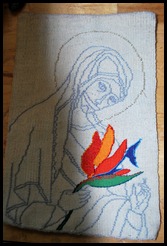
Hopefully, by looking closely you can see that there are 2 distinct areas of pipes on this piece. The first set is just basically organ pipes caused from using too much weft in the sleeve or cape above the hand. This could have easily been cured by using less weft in my bubble.
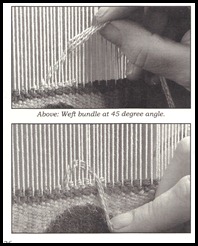
In the upper right hand corner is a type of organ pipe that is caused by weaving to close to the top bar that had been warped in a figure 8 pattern. As the warps or shed warps became further apart it took more weft to cover the warps because they were pulled further apart by the shed.
There is a fairly easy solution that I didn’t understand when I wove this piece. Completely loosen the warp, twi
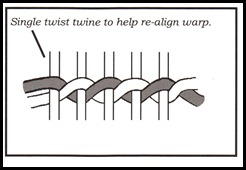 ne from side right above the fell line. use a fork pick the twining up and move it to the top of the loom right under the cross bar. You could also pick a shed and place a stick or batten in the closed shed under the twining and push the twining up to the top bar of the loom-effectively keeping the shed closed. Retighten the warp and weave the tapestry to the top. On a small loom you may need to needle weave the last passes. A small aside- This piece pulled in because I tried to weave it from side to side with one bobbin. If I had broken up the area into several smaller areas and wove them in the same colour using hatches or lazy lines the tapestry would not have woven in. Adding bobbins in a plain colour area shoves the woven areas out ass the turns place more weft in a smaller area rather then pulling in.
ne from side right above the fell line. use a fork pick the twining up and move it to the top of the loom right under the cross bar. You could also pick a shed and place a stick or batten in the closed shed under the twining and push the twining up to the top bar of the loom-effectively keeping the shed closed. Retighten the warp and weave the tapestry to the top. On a small loom you may need to needle weave the last passes. A small aside- This piece pulled in because I tried to weave it from side to side with one bobbin. If I had broken up the area into several smaller areas and wove them in the same colour using hatches or lazy lines the tapestry would not have woven in. Adding bobbins in a plain colour area shoves the woven areas out ass the turns place more weft in a smaller area rather then pulling in. Illustrations and pictures are copyrighted images from the book Tapestry 101 and were created by Pat Spark.
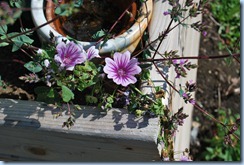
Guess that’s all for now. Hopefully in 2 weeks I can say and he is finished.
Cheers,
kathe
PS. These are wild Hollyhocks and usually stand 6-7 feet tall, but have decided to creep along the edge of my new herb garden, Who would have guessed.